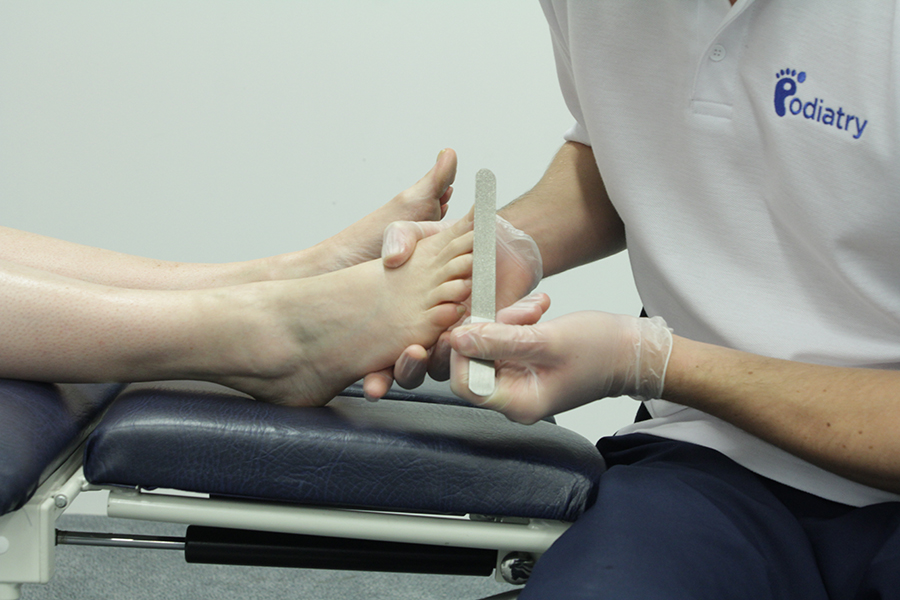Ingrowing toe nails
Download our Nail Surgery information pack

Nail
Surgery
Download our Ingrown toenail information pack

Ingrown
toenail
An ingrown toenail (onychocriptosis) can be very painful, and if left untreated the pain can affect a person's gait (the way we walk). Gait disturbances include limping, which can then put strain on other structures; and this can lead to further problems elsewhere. It usually affects the big toenail, on either one, or both sides of the nail, however any toe can be affected.
What are ingrown toenails?
Ingrown toenails occur when the side/s of the nail pierce, and then grow into the surrounding skin. The result is pain and inflammation, and in some cases infection.
What causes an ingrown toenail?
Some people are more prone to ingrownw toenails than others. For example, some people inherit a nail shape that makes then more susceptible. This type of nail is known as involuted and 'pincer'; the nail has a greater curve which creates a 'pinching' effect. Other causes include:
- Poor nail cutting
- Ill-fitting footwear
- Tight fitting socks and hosiery
- Fungal infection
- Poor foot hygiene and hyperhidrosis (excess sweating)
Who gets an ingrown toenail?
Anyone can get an ingrown toenail, however they are more common in:- Those who have an involuted or 'pincer' nail shape
- Teenagers
- Older people
- Those who participate in certain sports (e.g. running, football)

What are the signs and symptoms of an ingrown toenail?
Signs and symptoms of an ingrown toe nail vary depending on the severity and length of time the nail has been ingrown.
Early symptoms include:
- Pain (particularly when pressure is applied)
- Redness
- Heat
- Swelling
Later symptoms include:
- The toe may bleed
- Pus may be present
- Infection
- Greater swelling
If left untreated and an infection is present the infection can affect the bone leading to osteomyelitis (infection of the bone), or become systemic (affect the body through the bloodstream and not just local to the toe). Signs of systemic infection include:
- Fever,
- Chills
- Rapid pulse
- Joint aches
- Cellulitis
It is important to note that if you have any signs of systemic infection you must visit a doctor as soon as possible.
Types of ingrown toenail
Ingrown toe nails vary depending on the severity of the symptoms. An ingrown toe nail may be:
- Mild,
- Moderate
- Severe
- Infected.
How are ingrown toenails diagnosed?
Your podiatrist will be able to tell you whether or not you have an ingrown toenail and the best course of treatment.
Benefits of podiatry for an ingrown toenail
Your podiatrist can help relieve you of the pain and discomfort of an ingrown toenail. They can also provide information on correct nail cutting techniques, foot-care, and give advice on footwear; things which together can to help prevent future re-occurrence.
What would podiatry for an ingrown toenail involve?
This depends on the severity of the ingrown toenail presented. It may be that surgery is not necessary in all cases. To reach a decision on what is best for you, your podiatrist would first take a thorough medical and social history. They would then examine your feet, assessing your foot pulses, skin integrity, and the nails. The information provided during the assessment will then provide the podiatrist with the information necessary to assess your suitability for either conservative treatment or nail surgery.
If your nail is infected it may be necessary to take antibiotics prior to any surgery taking place. This is because infection can affect the effectiveness of the anaesthetic. Your podiatrist will advise you on this.
Your podiatrist will discuss the treatment options open to you.
Ingrown toenails can be treated either conservatively (non-surgical intervention) or surgically. Whether to treat surgically or conservatively depends on the severity of the symptoms and the individual patient. One may be favoured over the other for certain patient groups. Your podiatrist will be able to advise and explain the treatment most suitable for you, the decision of what to do then is up to you ' the patient.
The following treatments may be offered:
- Nail surgery. This involves removing either part of the nail (a partial nail avulsion), or the entire nail (a total nail avulsion) under local anaesthetic. A chemical called phenol (phenolization) is then applied to prevent the nail from growing back and causing the same problem to re-occur. If part of the nail is removed the remaining skin will eventually heal snug to the side of the nail, resulting in a 'normal' slimmer looking nail. Removing all or part of the nail has no effect on the function of the toe.
- Removal of nail spike. In some cases, particularly in the early stages, the 'nail spike' can be removed in clinic by the podiatrist. This can sometimes be a little uncomfortable, however it provides instant relief as the spike is removed. This, along with advice on nail cutting and footwear may be enough to prevent the need for nail surgery in the future.
- Packing. Packing involves placing tightly packed sterile gauze beneath the nail plate. The purpose of this is to allow the nail to grow up and over the gauze as opposed to into the skin. Again, this can be a little uncomfortable at first; however it may be a good option when conservative treatment is wanted and/or needed.
- Antibiotics (when infected)
- Paracetamol for pain
Summary
An ingrown toenail is a nail that punctures and then grows into the surrounding skin. The condition is painful and can lead to infection. Some people are more prone to ingrown toenails than others, they include; teenagers, older people, sports people, and those who have inherited involuted or 'pincer' shaped nails. Your podiatrist can diagnose and treat an ingrown toenail. Depending upon the severity and the patient's needs treatment can be either conservative or surgical. Surgery involves removing a portion of, or the entire nail under local anaesthetic (an injection into the toe that prevents you from feeling any pain).
To arrange an assessment with one our podiatrists please email office@chiropody.co.uk or call0330 088 4222Save 5% by booking an appointment online.



We work with:

Individuals

Organisations

Health professionals
Get in Touch!
0330 088 4222
If you would like to speak to one of our specialists then please complete this form.
We are open 7 days a week








